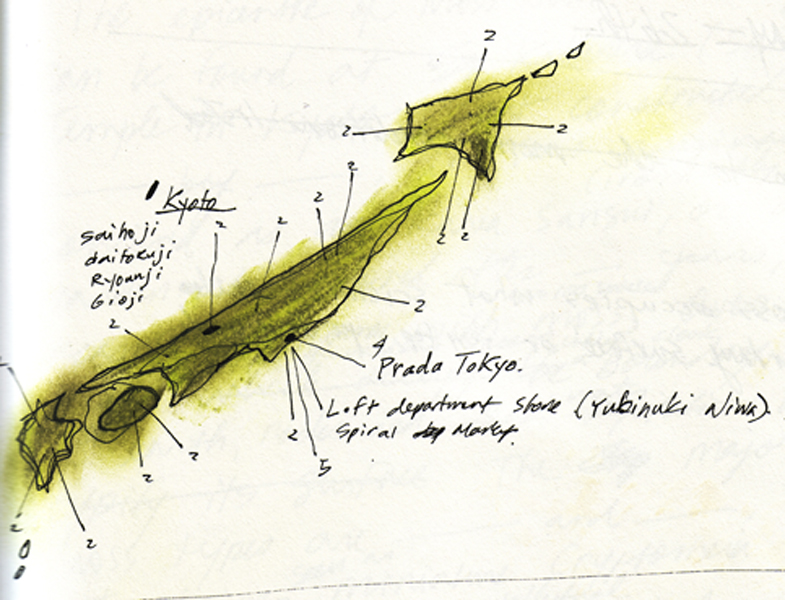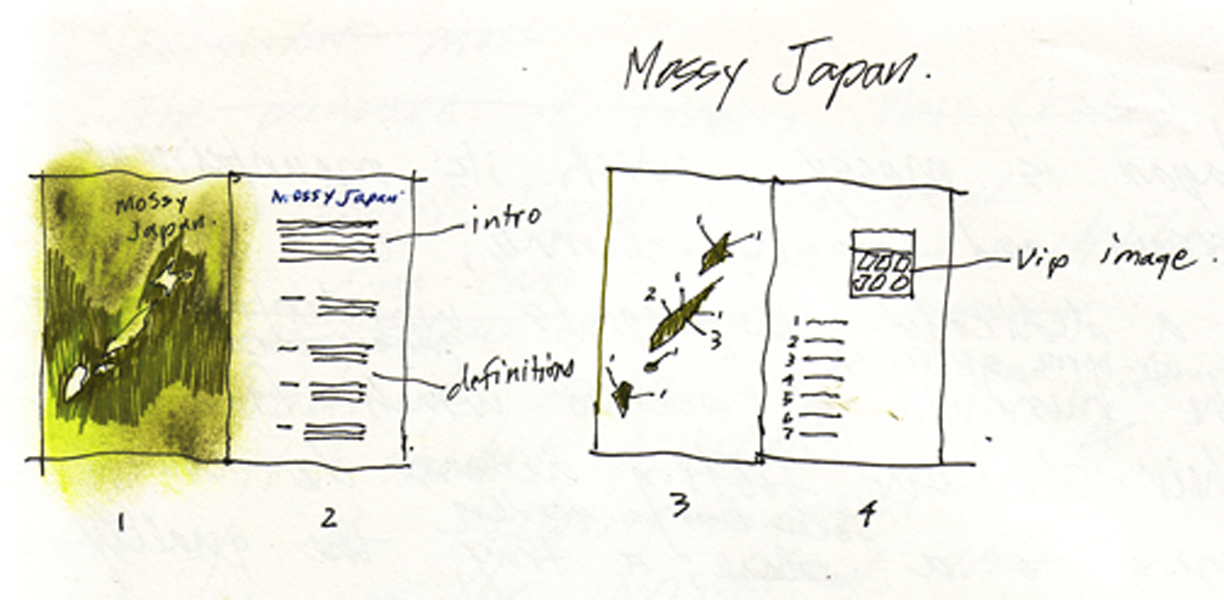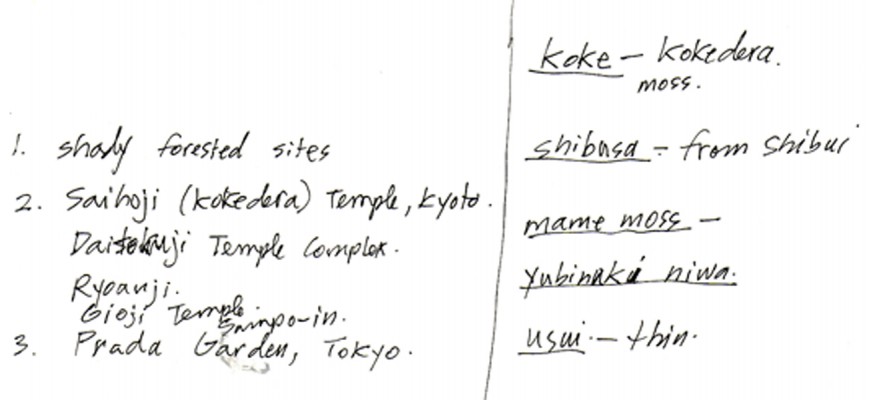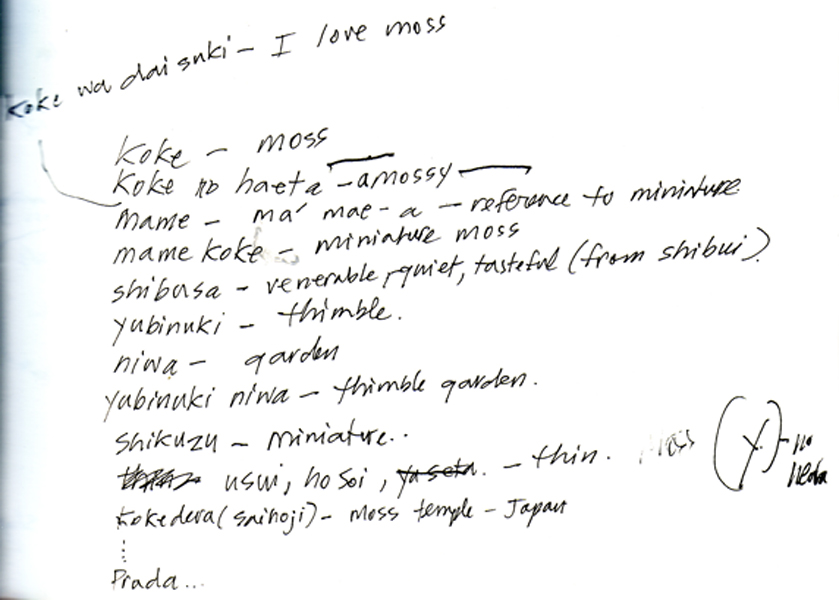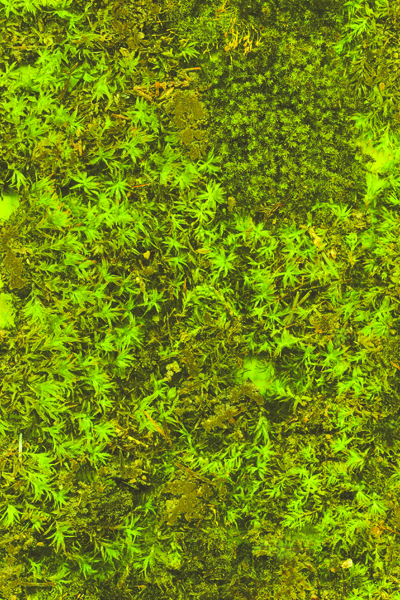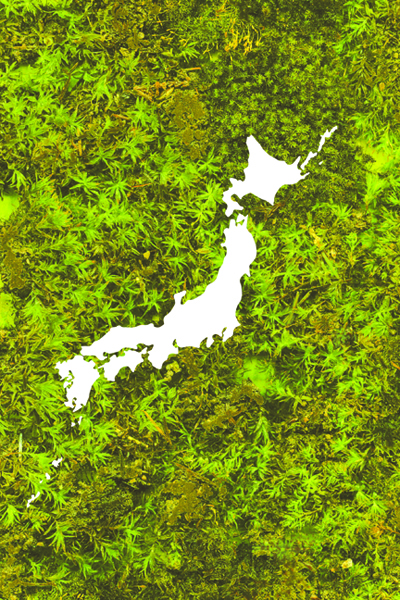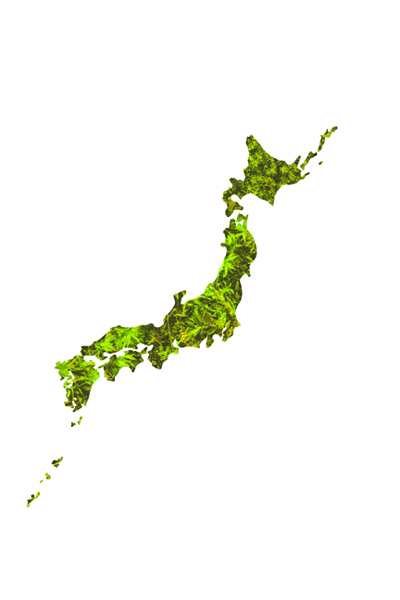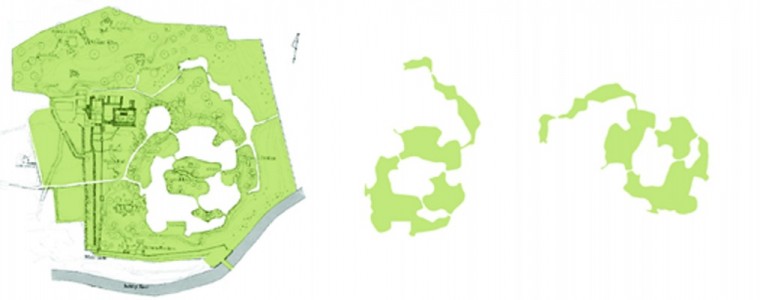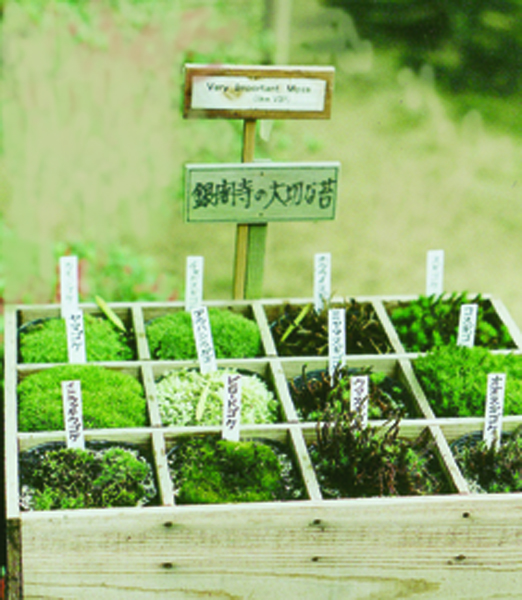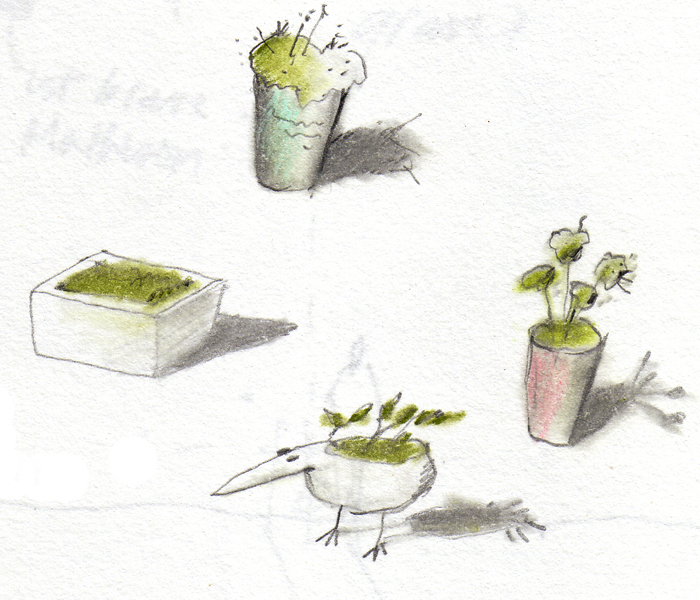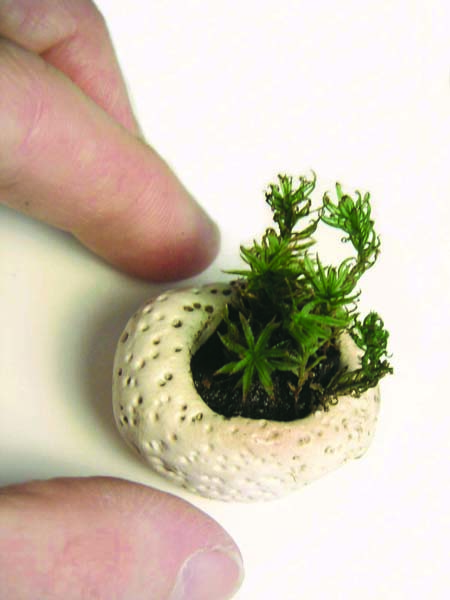Mossy Japan
Japan is mossy. With its mountainous terrain and moist climate, the country is a dedicated Bryologist’s verdant wonderland. Across its many geographies, air-borne spores of hundreds of species find their shallow footing and bring to a forest floor, a garden, a tray, the quality of shibusa. Shibusa is an aesthetic concept which is irreducible to just one English word but is associated with venerability, age, and time; softly proceeding. In a country like Japan, which aestheticizes the acceleration of technology, the notion of shibusa may be archaic but that is precisely its function; that is, it is a balancing, ameliorative force, where mossiness becomes a link to the mythologically charged origins of the country; a dipiction of original nature. Mosses are osmotic – that is, they do not have a vascular system to drink from the ground. Rather, they absorb cell to cell. Because mosses do not have roots, they are the ideal plant material for use in shallow and synthetic conditions; ideal for Japan, where the miniature can represent something far larger, and which long ago accepted the notion that representations of nature can occur in thin space – where flatness carries the semiotic reference to depth.
Miniature and thin space
The epicentre of moss culture in Japan can be found at Saihoji (Kokedera) temple in Kyoto. First constructed in the 8th century and redesigned in 1339 by priest Muso Kokushi, it was conceived as a Kare Sansui, or dry garden. It is perceived to be a depiction of paradise on earth in the Jodo sect of Buddhism. In the following centuries, it became overgrown with over 100 species of moss, a carpet of various greens which cloak a boundary layer of earth, rocks and water. The major moss types are leucobryum, polytrichum, and pogonatum, the latter being seen as miniature cryptomeria (cedar) trees by the Japanese. The intellectual projections of a scale change on an object or space is found everywhere in Japan, both in high and pop culture. The very surface of thin-ness becomes a reference to depth and territory. The cryptomeria example means that there are at least two ways to read the mossy carpets of Saihoji: one is real, soft, and hushed….the other is intellectual; a miniature allusion to a forest. We are floating a kilometer off of the ground when viewing the mossy terrain. However, Saihoji has a third level of scale reduction; the pond, which forms the aqueous focus of the garden is a calligraphic abstraction of the word kokoro or heart. The diagram above illustrates this fact. Of course, this does not read in real space but is only evident when one regards the garden from the sky or in plan view. The water is the only surface in the garden which is not mossy – even the trees are mossy. The water, however, is the life-blood of the moss and trees, an inseparable heart.
The garden exists, therefore, in several scales of representation; as a drawing, as a miniature and as a real space, from tiny to big.
Mitate
The fact that Saihoji exists in three states, that is, as an idea (drawing), as analogous (representational), and as real, renders it available for reinterpretation or ‘re-seeing’ (Mitate). Mitate is an operational device in which an object or condition is re-seen in an altered condition or material. The mossy garden can be found again and again throughout Japan in successive iterations of reduction and transformation. Sometimes they are experiential and spatial, other times flattened into picture planes. The bits and pieces of green tufts and carpets which characterize Zen gardens in Kyoto may be read as referents to the original mossy garden, which in itself refers back to the phenomena of original nature; a series of mitate. Ryoanji, the gardens Daitokuji, Gioji, and many others are masterpieces of moss manipulation. They can read as the islands of Japan, or miniature forests, or even as references to real geographies cited in classical literature. They are also the elemental antithesis of the gravel and rock compositions which abut them, forming visual, phenomenal and textural counterparts of green against the aridity of the dry gardens: wet/dry – the most primal of interdependencies. These gardens are meticulously maintained to exude a feeling of casual growth. The delicate contrast of moss with other elements is a theme which re-interprets gardens in Japanese landscape painting. In these paintings, flattened axonometric layers of space can portray wet/dry, light/dark, solid and void.
The further one is away from the real mossy forests and gardens of Japan, the more “miniaturized” moss becomes. Trays of moss become used in ‘mame’ or tiny Bonsai, and in department stores Yubinuki niwa (thimble gardens) are available for purchase. These tiny gardens are deeply connective omiage or souvenirs of idealized places. They echo sentiments of nature worship inherited from Shinto and Buddhist influences, produced by a culture where even the most insignificant rock or tree is a locus for deification. The moss therefore becomes not just a symbol of that condition but a real resting place for kami or gods. A god may visit you at your home, work desk, or dashboard.
Celebrity Moss
In Ginkakuji temple, Kyoto, there is a gridded wooden box which contains twelve species of moss. The sign in English says “V.I.P.” Very Important Plants. Aware that moss is famous in Japan, and that visitors know this, the sign carries with it some of the humour which is paired with Buddhist teachings. The Japanese may say “koke o taisetsu ni shite kudasai” – be moss friendly. By extension, this may be read as be nature friendly: watch out for the floor of the earth. In the light of the fact that so much of the ground plane and shoreline of Japan has been completely modified by synthetic construction, this is somewhat ironic. However, it bespeaks of a culture which retains and mythologizes an ideal floor of the earth; as for the mossy Japanese, moss is a highly charged depiction of a heavenly and original state of nature. Saihoji is a rarefied place in Japan. One needs a reservation to visit and must write a sutra and meditate before entering the famous garden. The layer of protocol elevates the site to a high status in the hierarchy of gardens in the country. The major conductor for its fame is now photography. The garden exists now in a fourth state, as a kind of elusive celebrity of space. Always emerald in a perfect state of mossyness.
The most recent celebrity moss garden in Japan is a ground plane context for Prada Aoyama, the new flagship store for the Italian clothier company. Located in the sanctified shopping nexus of Omotesando, Tokyo, this garden was designed by Herzog & deMeuron and opened in 2003. The moss tiles which form control vertices for this garden are attached to a gridded structure in which floor becomes wall. The thinness of the moss permits things like doors to be veneered with the moss material. Its overtly synthetic usage and pun on carpet tile produces an ambiguous effect as to its true nature. People argue over whether it is real or not. ‘How can green be so thin and geometric?’ they ask. Mossy Prada is a courageous experiment, a spatialized bonsai, a flat set of trays which hold moss. While it doesn’t overtly romanticize the idealized floor of a forest, it does refer to something outside of itself, it is a kind of talisman which connects to the old garden, albeit represented as a mossy wire frame. The garden also continues the tradition of fetishistic care which moss requires out of its natural context. Like all celebrities, its maintenance is an ongoing issue.
Essay
Bill Pechet for Tokyo from Vancouver, George Wagner, ed., UBC SALA, 2005.
Images
Bill Pechet and Tina Tajitsu – Yubinuki Niwa by Studio Flossnova Intl., a subsidiary of Pechet Studio
